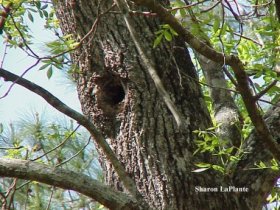
Is That a Dead Tree or Prime Real Estate?
by Linda Vanderveen
Before you decide to cut down and haul off that ugly dead tree, consider the housing needs of some of your feathered friends. That old dead tree (snag) might be the perfect shelter for one of the 25 cavity nesting birds in our state. Some birds such as woodpeckers, nuthatches, and chickadees, excavate cavities in dead or decaying wood for roosting and nesting. Cavities can't be excavated in trees with sound heartwood.
Roosting holes are important for protecting birds at night from cold weather and predators. Cavities for cavity nesting species are necessary to protect the young as the nestling period is somewhat longer than that of open nesting species. Lack of suitable trees for excavation can lead to fierce competition for available sites. Weaker birds can be evicted by more aggressive birds. For example, a red-bellied woodpecker couple can be chased off by a pair of red-headed woodpeckers, likewise, house-hunting starlings can take over nesting or roosting holes leaving the homeless tenants without any suitable nesting sites for the entire season.
When was the last time you heard that drumming sound coming from your neighborhood woodpeckers? Drumming is a form of long distance communication. It can announce claim to a territory, or attract a mate.
Many woodpecker species, upon finding a favorable tree, will seek their mate to take a closer look. If a mate is enthusiastic about a site, there will be some mutual nest excavating. If the site is unsuitable, the birds will have to start over. It may take repeated tries to find a suitable tree for a nesting site. In a young woodland with no dead trees a nesting site may not be available at all.
You might find a dead tree that has been used for a number of nesting seasons. The oldest roost hole will be at the top. A couple may return to the same tree for a number of years. Nest sites are usually in shorter supply for cavity nesters than food and water. Dead trees are often removed from parks, forests, and yards. Whenever possible snags should be left for the birds.
Our Florida cavity-nesters range in size from turkey vultures, with wing spans of six feet, to brown-headed nuthatches that are three and one-half inches long. The southeastern kestrel is a state-listed threatened species, and the red-cockaded woodpecker is a federally-listed endangered species. As you can see, the need for all sizes of housing is evident. So leave that dead tree alone and you might be well entertained by some new tenants.
Kilham, Lawrence. Life Histories of Woodpeckers of Eastern North America. Nuttall Ornithological Club Cambridge, Mass. 1983
Schaefer, Joe. Helping Cavity Nesters in Florida. University of Florida, Gainesville 1990.
Return to the Main Page
All material on this site © Hernando Chapter of the FNPS. The materials on this website may be copied and distributed without permission, provided that it is used for non-commercial, informational or educational purposes, and you acknowledge this site and the Hernando Chapter of the Florida Native Plant Society as the source of publication.